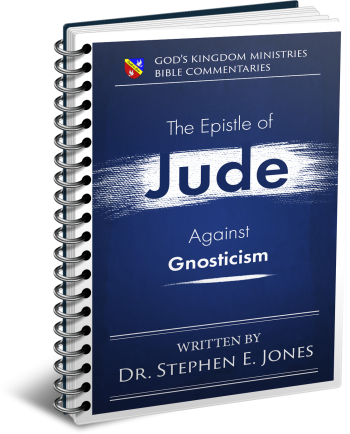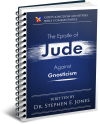Latest Posts
View the latest posts in an easy-to-read list format, with filtering options.

Jesus' brother, Jude, wrote a letter to the Jewish Christian congregations in the first century, warning them about Gnosticism and also urging them to stand firm in faith against their Jewish critics.
Category - Bible Commentaries

Jude 12 and 13 is a passage that uses multiple metaphors in describing the Gnostics infiltrating the early Church:
12 These are the men who are hidden reefs in your love feasts [agape] when they feast with you without fear, caring for [poimaino, “feeding”] themselves ; clouds without water, carried along by winds, autumn trees without fruit, doubly dead, uprooted; 13 wild waves of the sea, casting up their own shame like foam; wandering stars [planetes aster], for whom the black darkness has been reserved forever [aion, “eon, age”].
Jude uses five analogies to describe the Gnostics. The first is where Gnostics are “hidden reefs” when they are allowed to participate in the Eucharist.
By pretending to hold true knowledge of God, the Gnostics had infiltrated some of the early Church congregations, readily partaking of communion with them as if they were genuine Christians. The communion (“common union”) was called agape, “love, or love-feast,” because it was meant to express one’s love for God which was the basis of union with Him and with each other. Communion apart from love of the brethren violates the spirit of the love-feast.
The Septuagint translation of the Old Testament into Greek, which was the standard Greek version in use in the first century, renders Song of Solomon 2:4, “His banner over me is agape.” Isaiah 56:6 reads, “Also the foreigners who join themselves to the Lord, to minister to Him and to love [agape] the name of the Lord…” The concept behind “love” was to express one’s love of God and God’s love for us.
The Gnostics partook of communion “without fear,” Jude says, in spite of Paul’s warning in 1 Cor. 11:27-30,
27 Therefore whoever eats the bread or drinks the cup of the Lord in an unworthy manner, shall be guilty of the body and the blood of the Lord… 29 For he who eats and drinks, eats and drinks judgment to himself, if he does not judge the body rightly. 30 For this reason many among you are weak and sick, and a number sleep.
Jude says that they were “feeding themselves” but were not truly taking communion. That is, they could go through the act of partaking of the bread and wine, but they were not truly in fellowship with God or even with the Church, because they did not truly love God.
Perhaps, too, Paul was referring to a Gnostic corruption of communion when he says in 1 Cor. 11:34, “If anyone is hungry, let him eat at home, so that you may not come together for judgment.” It has been suggested that the Gnostics had turned the love-feasts into a counterfeit love according to their own beliefs.
In other words, they may have attempted to turn it into a gluttonous orgy. This may have been what Jude had in mind when he wrote earlier in Jude 4 about “ungodly persons who turn the grace of our God into licentiousness.”
Jude’s second analogy is that of clouds that do not produce any rain. In Scripture, rain was symbolic of the outpouring of the Holy Spirit. Hence, Gnosticism was a waterless cloud promising the Holy Spirit but coming up empty in the end. No doubt this refers to Simon Magus’ attempt to purchase the power to confer the Holy Spirit upon others (Acts 8:18, 19). The Gnostic desire to be the source of the Holy Spirit did not produce the latter rain at Pentecost, nor will it produce the early rain at Tabernacles in the future.
There were two seasons of rain in Palestine. The “former rain” occurred in October and November at the time of seed planting. The “latter rain” occurred between Passover and Pentecost in May, and it was necessary to ripen the wheat for harvest after Pentecost. The latter rain normally ceased by Pentecost, allowing men to harvest their wheat. So when Saul was crowned on Pentecost, the day of wheat harvest, Samuel prophesied of the outpouring of the Holy Spirit, saying in 1 Samuel 12:17, 18,
17 “Is it not the wheat harvest today? I will call to the Lord, that He may send thunder and rain. Then you will know and see that your wickedness is great which you have done in the sight of the Lord by asking for yourselves a king.” 18 So Samuel called to the Lord, and the Lord sent thunder and rain that day; and all the people greatly feared the Lord and Samuel.
Saul represented the church under Pentecost until the fulfillment of the feast of Tabernacles and the second coming of Christ. Saul was crowned on Pentecost, and so we find that Saul prophesied and was “changed into another man” (1 Samuel 10:6, 9, 10). The latter rain represented the outpouring of the Spirit at Pentecost, while the early rain represents prophetically the final outpouring of the Spirit that is yet to come at the Feast of Tabernacles.
Joel 2:23 says,
23 So rejoice, O sons of Zion, and be glad in the Lord your God; for He has given you the early [moreh] rain for your vindication [tsedaqah, “righteousness”], and He has poured down for you the rain, the early [moreh] and latter rain as before.
The Hebrew text contains an interesting double meaning which gives us another layer of prophecy in regard to the outpouring of the Spirit. It could just as easily be translated, “for He has given you the Teacher of Righteousness… as the early and the latter rain.” The Hebrew word moreh means “an archer, teacher,” as well as “early.”
In Hebrew metaphors, a teacher was like an archer hitting the bull’s eye in regard to truth. In bringing “rain,” a true teacher was a dispenser of truth through the Holy Spirit.
The Sadducees translated this verse as a reference to the Teacher of Righteousness, and they applied it to their own founder named Zadok (tsedaq). Hence, they called themselves followers of Zadok, or Zadok-ees, which the Greek spells as Sadducees).
As Christians, we know that the true Teacher of Righteousness was Jesus Christ, for He alone was able to ascend to heaven in order to send the Holy Spirit upon the disciples at Pentecost. John 16:7 and 8 says,
7 But I tell you the truth, it is to your advantage that I go away, for if I do not go away, the Helper [Comforter] shall not come to you; but if I go, I will send Him to you. 8 And He, when He comes, will convict the world concerning sin, and righteousness, and judgment.
The Holy Spirit is the Enforcer of God’s standard that measures truth. The Gnostics, however, had placed their faith and trust in Simon Magus, whom they called “The Great Power of God” (Acts 8:9, 10). He functioned as a counterfeit Teacher of Righteousness (as did Zadok of the Sadducees), and he pretended to be the only one who could lead the people into all truth by his teachings. However, Jesus contradicted that in John 16:13, for He spoke of the Holy Spirit that was to come at the feast of Pentecost.
The Holy Spirit had already come in Acts 2 before Simon Magus even came on the scene in Acts 8. That occasion, of course, was the latter rain. The early rain, associated with the feast of Tabernacles, will be a greater outpouring of the Holy Spirit, for it will prepare the ground for a much greater harvest in days to come.
Jude 12 also says that the waterless clouds were “carried along by winds.” The Greek word anemos, “winds,” is a strong tempest or storm, as we see in Matt. 7:27,
27 And the rains fell, and the floods came, and the winds [anemos] slammed against that house; and it fell—and great was its fall.
Normally, a tempest would produce a great deal of rain, but the Gnostics were like a great tempest that promised floods but provided no rain. By contrast, on the day of Pentecost we read in Acts 2:2,
2 And suddenly there came from heaven a noise like a violent rushing wind [pnoa], and it filled the whole house where they were sitting.
This “wind” (pnoa) was the Holy Spirit, bringing the latter rain, which bore fruit in the wheat harvest that followed. The word pnoa is from the root word pneo, which is also the root word for pneuma, “spirit, breath, wind.” Although the wind came into the upper room like a tempest, it was not devoid of rain, for the Spirit of God was indeed poured out as prophesied. The book of Acts tells us how the power of God worked in the early church as a direct result of Pentecost.